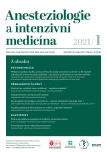Positive pressure application of oxygen using Venturi nozzle Corovalve made on a 3D printer.
A simple and inexpensive method applicable in emergency conditions on a mass scale
Authors:
V.- Rogozov 1 4; A. Furdová 1; D. Ďurica 5; T. Vaněk 1,3; M. Reichertová 1; B. Filipová 1; P. Kačer 1
Authors‘ workplace:
Kardiochirurgická klinika, FN Královské Vinohrady, Praha
1; Department of Anaesthesia, Leeds Teaching Hospitals, Leeds
2; 3. lékařská fakulta, Univerzita Karlova, Praha
3; School of Medicine, University of Leeds, Leeds
4; Klinika dětské a dospělé ortopedie a traumatologie 2. LF UK a FN Motol, Praha
5
Published in:
Anest. intenziv. Med., 32, 2021, č. 1, s. 9-13
Category:
Original Article
Overview
Acute hypoxemic respiratory failure (which occures also with severe course of COVID-19) requires oxygen therapy. The in vasiveness and intensity of chosen therapy corresponds with patient’s condition and technical means available. If a large number of patients with hypoxic failure suddenly occur, the available equipment and/or human capacity to provide effective oxygen therapy may be greatly strained.
The goal of our experiment was to test functionality of a simple device equipped with a Venturi nozzle Corovalve which we designed and printed on a 3D printer.
We incorporated the nozzle into a system assembled from parts commonly available in the Czech Republic. We put this device through a static test and a dynamic test performed on ourselves and measured its basic parameters.
In our experiment during spontaneous ventilation the device was able to generate positive mean airway pressure. At higher flow rates, the system was able to maintain a slightly positive pressure even during the inspiration, so we can talk about a system that allows, under certain circumstances, spontaneous ventilation at continuous positive airway pressure.
The most effective from setting tested was oxygen input of 15 L/min combined with PEEP valve set to 10–15 cm H 2 O. Mean airway pressure ranged at 9–12 cm H 2 O and oxygen concentration in the inspiration mixture was 40–42%.
We therefore conclude that our nozzle Corovalve printed on a 3D printer can be used in a simple device allowing positive pressure oxygen application during spontaneous ventilation EPAP/CPAP. It is economical and easy to provide method and therefore of a rather interesting potential. With a sufficient number of 3D printed nozzles it could be deployed quickly and on a mass scale.
Keywords:
COVID-19 – oxygen therapy – CPAP – Venturi nozzle – 3D printing – Corovalve
Sources
1. Nicholson TW, Talbot NP, Nickol A, Chadwick AJ, Lawton O. Respiratory failure and noninvasive respiratory support during the covid-19 pandemic: an update for re‑deployed hospital doctors and primary care physicians. BMJ 2020; 369: m2446. doi: 10.1136/bmj.m2446.
2. Nightingale R, Nwosu N, Kutubudin F, Fletcher T, Lewis J, Frost F, et al. Is continuous positive airway pressure (CPAP) a new standard of care for type 1 respiratory failure in COVID-19 patients? A retrospective observational study of a dedicated COVID-19 CPAP service. BMJ Open Respir Res. 2020; 7(1): e000639. doi: 10.1136/bmjresp-2020-000639.
3. Oranger M, Gonzalez‑Bermejo J, Dacosta‑Noble P. Continuous positive airway pressure to avoid intubation in SARS‑CoV- 2 pneumonia: a two‑period retrospective case‑ control study. Eur Respir J 2020. doi: 10.1183/13993003.01692-2020. pmid: 32430410.
4. Culmer C, Keeling A, Osnes C, Birch WD, Jones D, Waters I, et al. Delivery of CPAP respiratory support for COVID-19 using repurposed technologies. medRxiv [on‑line] [2020-04-19]. Dostupné z: https://doi.org/10.1101/2020. 04. 06.20055665.
Labels
Anaesthesiology, Resuscitation and Inten Intensive Care MedicineArticle was published in
Anaesthesiology and Intensive Care Medicine

2021 Issue 1
Most read in this issue
- Doporučení pro anestezii a sedaci u kojících žen
-
Point of care examination of blood clotting –
current possibilities - Ketamin – nezávislost disociativní a analgetické působnosti
- Fascial planes for regional anesthesia of the lower limb
